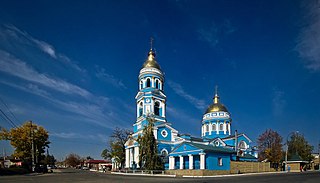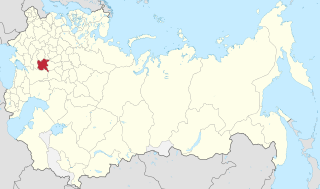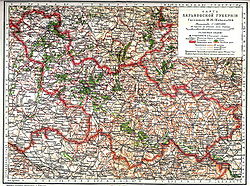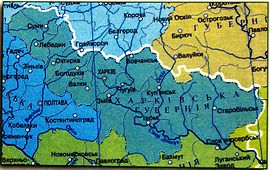A governorate was a major and principal administrative subdivision of the Russian Empire. After the Bolshevik Revolution in 1917, governorates remained as subdivisions in the Byelorussian, Russian and Ukrainian Soviet republics, and in the Soviet Union from its formation in 1922 until 1929. The term is also translated as government or province. A governorate was headed by a governor, a word borrowed from Latin gubernator, in turn from Greek κυβερνήτης.

Sloboda Ukraine, usually referred to locally as Slobozhanshchyna, is a historical region located in northeastern Ukraine and southwestern Russia. It developed and flourished in the 17th and 18th centuries on the southwestern frontier of the Tsardom of Russia. In 1765, it was converted into the Sloboda Ukraine Governorate.

Izium or Izyum is a city on the Donets River in Kharkiv Oblast, eastern Ukraine. It serves as the administrative center of Izium Raion. Izium hosts the administration of Izium urban hromada, one of the hromadas of Ukraine. It is about 120 kilometres (75 mi) southeast of the administrative center of the oblast, Kharkiv.
Derhachi is a city in Kharkiv Raion, Kharkiv Oblast, eastern Ukraine. The town is 12 km (7 mi) northwest of the administrative center of the oblast, Kharkiv. The settlement was founded in the second half of the 17th century as a sloboda. It hosts the administration of Derhachi urban hromada, one of the hromadas of Ukraine. Population: 17,139.

Kherson Governorate, known until 1803 as Nikolayev Governorate, was an administrative-territorial unit (guberniya) of the Russian Empire, with its capital in Kherson. It encompassed 71,936 square kilometres (27,775 sq mi) in area and had a population of 2,733,612 inhabitants. At the time of the census in 1897, it bordered Podolia Governorate to the northwest, Kiev Governorate to the north, Poltava Governorate to the northeast, Yekaterinoslav Governorate to the east, Taurida Governorate to the southeast, Black Sea to the south, and Bessarabia Governorate to the west. It roughly corresponds to what is now most of Mykolaiv, Kirovohrad and Odesa Oblasts in Ukraine and some parts of Kherson and Dnipropetrovsk Oblasts.

Yekaterinoslav Governorate was an administrative-territorial unit (guberniya) of the Russian Empire, with its capital in Yekaterinoslav. It bordered Poltava Governorate to the north, Don Host Oblast to the east, Sea of Azov to the southeast, Taurida Governorate to the south, and Kherson Governorate to the east, and covered the area of the Luhansk, Donetsk, Dnipropetrovsk, and Zaporizhzhia Oblasts of modern Ukraine.

Poltava Governorate was an administrative-territorial unit (guberniya) of the Russian Empire. It included the territory of left-bank Ukraine and was officially created in 1802 from the disbanded Little Russia Governorate, which was split between Chernigov and Poltava Governorates with its capital in Poltava.

Tiflis Governorate was an administrative-territorial unit (guberniya) of the Caucasus Viceroyalty of the Russian Empire with its capital in Tiflis (Tbilisi). In 1897, it constituted 44,607 square kilometres (17,223 sq mi) in area and had a population of 1,051,032 inhabitants. Tiflis Governorate bordered Elizavetpol Governorate to the southeast, Erivan Governorate to the south, Kars Oblast to the southwest, Batum Oblast to the west, Kutaisi Governorate to the northwest, Terek Oblast to the north, Dagestan Oblast to the northeast, and after 1905, the Zakatal Okrug to the east. Governorate covered areas of central and southeastern Georgia, the partially recognised state of South Ossetia, most of the Lori Province of Armenia, small parts of northwestern Azerbaijan, and a minuscule southern part of Ingushetia of Russia.

Kiev Governorate was an administrative-territorial unit (guberniya) of the Russian Empire from 1796 to 1919 and the Ukrainian Soviet Socialist Republic from 1919 to 1925. It included the territory of the right-bank Ukraine and was formed after a division of the Kiev Viceroyalty into Kiev and Little Russia Governorates in 1796. Its capital was in Kiev. By the early 20th century, it consisted of 12 uyezds, 12 cities, 111 miasteczkos and 7344 other settlements. After the October Revolution, it became part of the administrative division of the Ukrainian SSR. In 1923 it was divided into several okrugs and on 6 June 1925 it was abolished by the Soviet administrative reforms.

During its existence from 1919 to 1991, the Ukrainian Soviet Socialist Republic consisted of many administrative divisions. Itself part of the highly centralized Soviet Union, sub-national divisions in the Ukrainian SSR were subordinate to higher executive authorities and derived their power from them. Throughout the Ukrainian SSR's history, other national subdivisions were established in the republic, including guberniyas and okrugs, before finally being reorganized into their present structure as oblasts. At the time of the Ukrainian SSR's independence from the Soviet Union, the country was composed of 25 oblasts (provinces) and two cities with special status, Kiev, the capital, and Sevastopol, respectively.

Kharkiv Governorate was a governorate of Ukraine from 1918 to 1925.

Chernihiv Governorate was an administrative-territorial unit of the Ukrainian State and the Ukrainian SSR, existing from 1918 to 1925. It was inherited from the Russian system of territorial subdivisions that existed prior to World War I. Specifically, Chernigov Governorate, also known as the Government of Chernigov, was an administrative-territorial unit (guberniya) of the Russian Empire. It included the territory of the left-bank Ukraine and was officially created in 1802 from Malorossiya Governorate with its capital in Chernigov (Chernihiv). Little Russian Governorate was transformed into the General Government of Little Russia and consisted of Chernigov Governorate, Poltava Governorate, and later Kharkov Governorate.

Voronezh Governorate was an administrative-territorial unit (guberniya) of the Tsardom of Russia, the Russian Empire, and the Russian SFSR, which existed from 1708 to 1779 and again from 1796 to 1928. Its capital was located in Voronezh since 1725.

Nizhny Novgorod Governorate was an administrative-territorial unit (guberniya) of the Russian Empire, Russian Republic, and the Russian SFSR, roughly corresponding to the Upper and Middle Volga region and what is now most of the Nizhny Novgorod Oblast. In the early of 20th Century, Nizhny Novgorod Governorate bordered Kostroma and Vyatka governorates to the north, Vladimir Governorate to the west, Kazan and Simbirsk governorates to the east, and Penza with Tambov governorates to the south.
Bogodukhovsky Uyezd was an uyezd (district) in the Kharkov Governorate of the Russian Empire.
Lebedinsky Uyezd was an uyezd (district) in the Kharkov Governorate of the Russian Empire.
Akhtyrsky Uyezd was an uyezd (district) in the Kharkov Governorate of the Russian Empire, Ukrainian State and Soviet Ukraine
Kharkovsky Uyezd was an uyezd (district) in the Kharkov Governorate of the Russian Empire.
Zmiev uyezd was an uezd (district) in the Kharkov Governorate of the Russian Empire.

The abolition of the Cossack system in Sloboda Ukraine was an administrative and military reform of the government of the Russian Empire, carried out in 1763-1765 and aimed at eliminating the autonomy of the Sloboda Cossack regiments. As a result of the reform, Russian state institutions began to operate on the territory of Sloboda Ukraine, and the Cossack regiments were reformed into Hussar regiments. The Kharkov Governorate with its center in Kharkiv was formed on the territory of the Sloboda regiments.



























